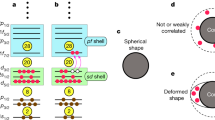Summary
Ilford G.5 plates were exposed to slow π--mesons produced by the Rochester Cyclotron. About 1500 σ-stars were classified according to the number of prongs and according that they were produced in a light nucleus (C, N, O) or a heavy nucleus (Br, Ag) of the emulsion. The examination of stars produced in the light nuclei has allowed to investigate the modes of desintegration of these nuclei. An extension of the scheme of Clark and Ruddlesden is proposed which gives an account of about 2/3 of the observed stars. The remaining stars contain at least one fragment (Z > 2) and seem better interpreted by a mechanism of local heating.
Riassunto
Lastre Ilford G.5 sono state esposte ai mesoni π- lenti prodotti dal ciclotrone di Rochester. Circa 1500 stelle σ sono state classificate secondo il numero dei rami e secondo che sono state prodotte in un nucleo leggero (C, N, O) o in un nucleo pesante (Br, Ag) dell’emulsione. L’esame delle stelle prodotte nei nuclei leggeri ha permesso di studiare i modi di disintegrazione di tali nuclei. Si propone un’estensione dello schema di Clark e Ruddlesden che dà ragione di circa 2/3 delle stelle osservate. Le restanti stelle contengono almeno un frammento (Z > 2) e sembra si possa interpretarle meglio con un meccanismo di riscaldamento locale.
Similar content being viewed by others
References
D. H. Perkins:Phil. Mag.,40, 601 (1949).
M. G. K. Menon, H. Muirhead etO. Rochat:Phil. Mag.,41, 583 (1950).
S. Enomoto, Y. Fujimoto, S. Horie etY. Tsuzuki:Progr. Theor. Phys.,7, 353 (1952).
V. De Sabbata, E. Manaresí etG. Puppi:Nuovo Cimento,10, 1704 (1953).
P. Ammiraju, M. Rinehart, K. C. Rogers etL. M. Lederman:Bull. Am-. Phys. Soc, 30/1, 49 (1955).
A. C. Clark etS. N. Ruddlesden:Proc. Phys. Soc., A64, 1064 (1951).
G. Vanderhaeghe: CERN, BS/1 (1954).
W. Cheston etL. Goldfarb:Phys. Rev.,78, 683 (1950).
M. Beneventano, D. Carlson-Lee, G. Stoppini, G. Bernardini etE. L. Goldwasser:Nuovo Cimento,12, 156 (1954).
F. L. Adelman etS. B. Jones:Science,111, 226 (1950).
F. L. Adelman:Phys. Rev.,85, 249 (1952).
K. J. Le Couteue:Proc. Phys. Soc, A63, 259 (1950).
D. H. Perkins:Nature,161, 487 (1948).
J. Heidmann etL. Leprince-Ringuet:Gompt. Bend. Ac. Sc. Paris,226, 1716 (1948).
Author information
Authors and Affiliations
Additional information
Chercheur agréé de l’Institut Interuniversitaire des Sciences Nucléaires (Belgique).
Rights and permissions
About this article
Cite this article
Demeur, M., Huleux, A. & Vanderhaeghe, G. Désintégrations des noyaux légers de l’émulsion nucléaire par des mésons π- lents. Nuovo Cim 4, 509–525 (1956). https://doi.org/10.1007/BF02745375
Received:
Published:
Issue Date:
DOI: https://doi.org/10.1007/BF02745375




